As my 2016 running plans developed, it became clear that it would be a year of races repeated. Without a doubt, three races meant the most to me in 2015: the Moab Red Hot 33k, the Hardrock 100, and the Ultra-Trail Gobi Race.
Taken individually, those three races are about as different as can be while remaining within the sphere of trail running. However, in repeating each one just one year later, I’d be able to refine and, subsequently, test my training, logistics, and execution in each.
The Idea
At its core, trail running is highly variable. To many, that is, in fact, one of the sport’s biggest draws. Hear, hear!
However, from time to time, eliminating some of that variability by running the same race more than once and, particularly, in sequential years when memories are fresher can allow you to hone your own training, logistics, and execution for that race. What’s more, some of the lessons you learn from the successes and failures of those modifications can be applied to other races (and runs), as well!
To this last point, it can be useful to modify some aspects of your race preparation and implementation solely as a test to apply to other races in the future. That said, purposeful experimentation might best be limited to events other than your focus races.
Now, on to some examples of areas where you might modify your race training, logistics, and execution.
Modifying Training
Many of us run races at least in part as a physical test. Once we venture onto challenging terrain and longer distances, these races tend to uncover specific weaknesses rather than simply running into the wall of cardiovascular ability as we might in, say, a 5k on the track.
For example, one’s calves could cramp while charging up slickrock in the Red Hot 33k, one’s quads could give out in Hardrock’s endless descents, or one’s hip flexors could fatigue during the expansive flat stretches of UTGR. We might also learn about our broader systems, such as having plenty of endurance for the Red Hot 33k, but having not adequately trained closer to one’s red line.
On the other hand, actually running a race can inform us that a particular concern had us overweight an aspect of our training and we can tone that down ahead of a repeat performance, allowing us to put more time and effort toward another aspect of training.
Modifying Logistics
I’ll admit that I’m the sort of person who enjoys geeking out over details for some races. No, I don’t have an Excel chart of how many gels I plan to eat between each aid station at Hardrock, but I do like contemplating how I can make the most of the outside constituents — the food, fluids, gear, lack of gear, etc. — that I can use in a race.
One easy way to modify logistics between runnings of the same race is to see which gear, fluid, or fuel you carried in year one and carefully consider if you can ditch it the next time. Heck, you can do the same analysis with items you carried and used only because you had them. Likewise, think to what you needed or, at least, should have had … but didn’t. Did you cut it too close with your clothing choice up on that high ridge? You can make the right call the next time.
Modifying Execution
While improving execution from one race to the next may seem like a race-day exercise, the greatest gains can be made in looking back at the prior experience and seeing what worked (and attempting to recreate it) and what didn’t work (and modifying it). On the physical side, in retrospect were there stretches when you pushed too hard, too soon or times when you relaxed when you could have made up some ground.
Unlike even races of the same distance on different courses, running the same route again really allows you to dial in the details of pacing and effort. While modifications to one’s outlook or emotional focus are a bit more ambiguous, you might focus on keeping a better attitude on stretches where you might get frustrated or bring a little more fight where you found yourself distracted.
Applying the Idea to My 2016 Calendar
The above might sound a bit nebulous at times, so below I share examples of how I have or hope to use my repeated races to fine tune my training, logistics, and execution in 2016.
Red Hot Moab 33k
The Red Hot Moab 33k has come and gone. Unfortunately, a persistent lower-leg injury related to an earlier trauma cropped up in late October last year, so I avoided running even as much speedy training as I had the prior winter. That said, I was proud to have modified my training and fitness to be more of the diesel-engine variety with many-mile climbs up steep road grades such that I was within 20 seconds of my time from 2015. In a race that short, I didn’t really have any logistics to modify, and my execution was similar. I’ll take that as a wash.

Running this year’s Red Hot Moab. Photo: Chris Hunter
Hardrock 100
Now, nine days before the Hardrock 100, it’s not surprising that this run is front and center in my mind. While I’m beyond pleased with how last year’s outing went, it was my first attempt at Hardrock and even going into that run I knew there’d be plenty I’d want to tweak before any second attempt. Here are examples of where I think I have or can make positive changes for this year’s run.
Hardrock Training Changes
- Last year, I tailored my training toward being able to finish Hardrock. That meant a very strong focus on accumulating tough descent, particularly in my June training push. With my quads tiring for the first time on the final descent in 2015, that worked. However, it also meant that I could cut back on this focus slightly before any subsequent runnings of Hardrock.
- Sure, there’s a whole lot of hiking in Hardrock. You spend far more time walking uphill than anything else. That said, there are still hours of reasonable running to be had. Last year, I didn’t purposely include any flat running ahead of Hardrock. This year, I’ll have five or six runs of 20 miles on the roads up above Silverton in which I try to run every step without pause. I hope that late in the race these runs give me a bit more strength and confidence to run down to Sherman, along Pole Creek, and back into Silverton.
- My weekly volume was all over the place in the six months leading up to last year’s Hardrock and I aimed for that not to be the case this year. I succeeded through much of the winter with a stretch of 10 consecutive, 50-mile weeks, but work and life made for more down weeks in the spring than I would have liked.
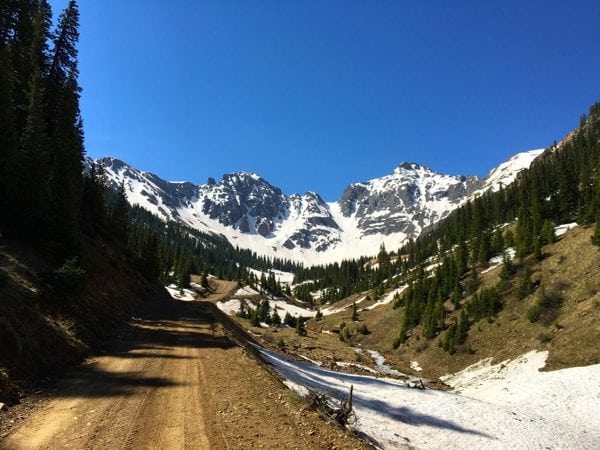
The turn around point for my road 20 miler above Silverton. Photo: iRunFar/Bryon Powell
Hardrock Logistics Changes
- At the time, last year’s Hardrock was the longest outing I’d ever been on and, as such, fueling was going to be an experiment on the go. With that in mind, I loaded up my crew with a ridiculous variety of foods, not knowing what would work and when. Now, knowing what I enjoyed the most during the race (in a race like Hardrock, I’ll choose foods I want to eat over what might have a slight nutritional advantage), I’ll load up on some favorites from last year. So, I’ve got heaps of UnTapped! Maple Syrup pouches, Skratch drink packets, and Skratch Fruit Drops, as well as a mix of GU, CLIF, and original Honey Stinger gels and chews. While favorites are awesome, some variety hits the spot!
- I also learned that I really wanted more solid food than I ate during last year’s Hardrock. That’d explain the five boxes of Little Debbie Cosmic Brownies that I have awaiting the race.
- I lucked out last year and got away with an ultralight windshell as my jacket. While a perfect forecast might have me carry the same jacket at times, I’ll be much more prone to carry a full waterproof jacket if there’s any chance of storms. A few less ounces are not worth the risk of hypothermia!
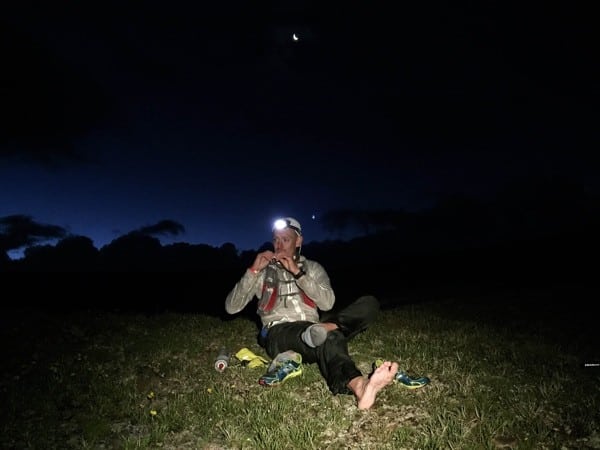
I had /just/ enough clothing during last year’s Hardrock. Photo: Joe Grant
- In fact, I’d be much more prone to throw gloves, pants, or a long-sleeve tee in my pack than I was last year. I generally trend toward carrying less in subsequent runnings of any race, but my experience in last year’s race, during some runs in Tibet this spring, and in training on the course this year has increased my caution while running in remote places with unpredictable weather.
- In recent training, I’ve also confirmed my post-race thought from last year that throwing a size medium jacket on over my pack is far quicker and more efficient that having to take my pack on and off to wear a size small jacket.
- With Hardrock reversing direction every other running, I can’t really tweak my plans for each crewed aid station as I’ve never run them in this sequence.
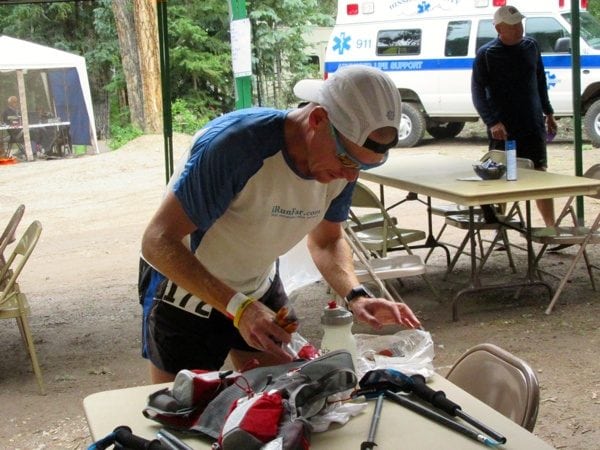
Getting things done solo at the Sherman aid station. Photo: iRunFar/Marissa Harris
Hardrock Execution Changes
- I felt like I went out easy in last year’s run, but I hope to go out even more conservatively this year. That’s tricky, as I’ll base that off of effort rather than pace or place.
- Climb better the last 25 miles. Perhaps, this is just the other side of the coin for the above point, but I’d like to be able hike with a bit more purpose and many fewer rest breaks on the climbs than I did after Telluride last year. Oh, and this probably has something to do with the next point, as well.
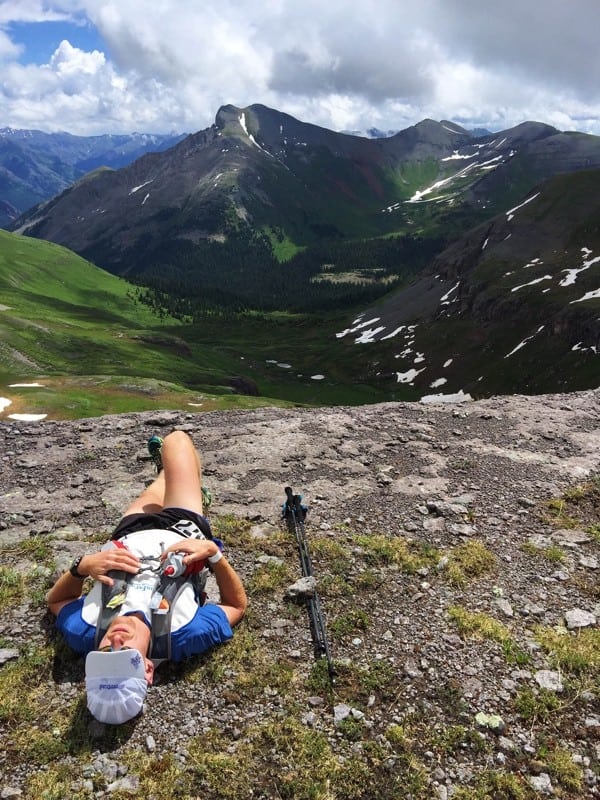
Enjoying a breather above Putnam Basin. Photo: Joe Grant
- For the past 11 months, I felt like I’ve been uncertain as to why I had no energy climbing the final 40 miles last year. I wasn’t sure whether it was a lack of calories or the cumulative effect of effort at elevation. Well, to clarify that uncertainty I should have simply watched my own post-Hardrock interview. I would have been reminded that I consumed roughly 1,000 kCal the final 45 miles, which amounted to 17 hours. Even if I underestimated that caloric uptake by half, that’s still ridiculously too few. I’ll do my best even if and when I don’t want to eat late in this year’s run.
- I also won’t plan on using trekking poles. I found that last year, I ate a whole lot less when I had trekking poles and been the case in the past, as well. I will have poles with my crew and certainly won’t hesitate to use them.
- I had fun taking around 800 photos during last year’s race. I aim to cut back on that.

Climb Grant-Swamp Pass with poles in 2015. Photo: Joe Grant
Ultra-Trail Gobi Race
While it’s a ways off, I hope I’m able to make it to the start line of the Ultra-Trail Gobi Race again in September. I’ve already got a slew of changes I’m eager to implement in terms of training, logistics, and execution.
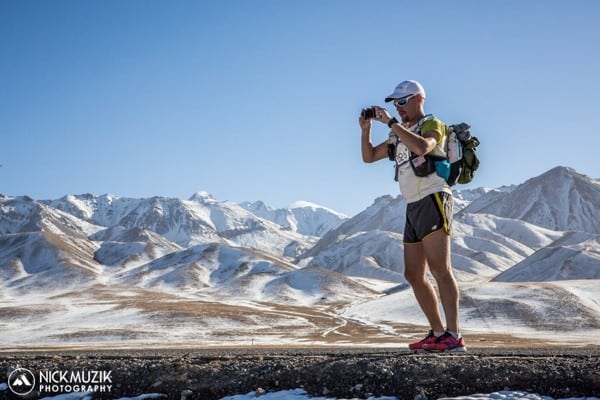
More running and fewer photos next time! Photo: Nick Muzik
Call for Comments
- Where have you found that you’re able to make positive changes ahead of or during subsequent runnings of a race?
- Have any favorite examples of how you’ve improved at a race and what lead to that improvement?
- On the flip side, do any of you actively avoid running the same race twice to maximize the variety of races you run?
